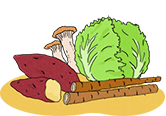Polydextrose
What is polydextrose?
Polydextrose is a safe dietary fiber made by mixing glucose, sorbitol, and citric acid.
Originally developed as excipients (inactive additives in food), these function as healthier low-calorie replacements for oils, fats and sugars.
Is polydextrose safe?
The U.S. Food and Drug Administration (FDA) approved polydextrose as a low-calorie food ingredient in 1981. Japan approved it as a food in 1983.
In Japan it is approved by the government as a safe food ingredient and is used in health drinks and processed foods, among other applications.
How polydextrose works in the body
1.Slows digestion of sugars, helping prevent rises in blood sugar
In a large-scale clinical trial investigating the glycemic index conducted under Professor J. Zhong of Shanghai University in China, 120 students took 50 grams of glucose together with 12 grams of polydextrose. The experiment found that the polydextrose lowered the rise in blood sugar and reduced the glycemic index by 12%. It has also been suggested that lowering the rise in blood sugar reduces excess secretion of insulin, which in turn slows fat accumulation.
Source: Zhong, J., et al. Am J Clin. Nutr. 72: 1503-9 (2000)
2.Adsorbs and helps excrete bile acid
Polydextrose is said to adsorb bile acid, helping excrete it as stool. Moreover, since bile acid is made from cholesterol in the liver, this action results in a reduction in blood cholesterol.
3.Increases good bacteria in the intestines
Polydextrose reduces bad bacteria in the intestines, which has the effect of increasing good bacteria. When eight healthy adult men and women drank a beverage containing polydextrose with a high cholesterol diet, the number and detection rate of bad bacteria in their stools decreased.
Characteristics of polydextrose
| (1) Low calories | 0kcal per gram |
|---|---|
| (2) Low viscosity | Dissolves well in water, is smooth and has low viscosity |
| (3) Does not cause tooth decay | Does not form contribute to oral bacteria Causes fewer cavities |
| (4) Sweetness: zero | Tasteless, odorless, zero sweetness Very little sweetening affect, any flavoring possible |
| (5) Safety | Approved by the FDA as a food ingredient and used in Japan as a "food" |
| (6) Dietary fiber | Indigestible, water-soluble dietary fiber |






